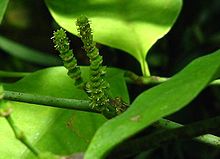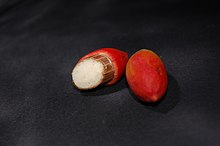Gnetum gnemon
| Gnetum gnemon | ||||||||||||
|---|---|---|---|---|---|---|---|---|---|---|---|---|

Leaves and seeds of Gnetum gnemon |
||||||||||||
| Systematics | ||||||||||||
|
||||||||||||
| Scientific name | ||||||||||||
| Gnetum gnemon | ||||||||||||
| L. |
Gnetum gnemon is a species of the genus Gnetum . The distribution area ranges from China to New Guinea to Fiji . The seeds, leaves and fruit clusters are edible, ropes and nets are made from the bark and the wood is also used in many ways.
description
Vegetative characteristics
In contrast to many other Gnetum species that grow as lianas, Gnetum gnemon forms evergreen shrubs or small trees with heights of up to 10 meters . The treetop is narrow. The bark is gray-brown. The branches resemble lianas and have a green or yellow-green bark .
The opposite arranged leaves are divided into a petiole and a leaf blade. The petiole is 0.5 to 1.8 inches long. The leathery or membranous, simple leaf blade is elliptical or oblong with a length of 7.5 to 20 centimeters and a width of 2.5 to 10 centimeters. The leaves are dark green and glossy and when dried yellowish-green. The base of the spade narrows towards the stem, the edge is entire, the upper end of the spade is pointed or prickly. The lateral leaf veins are inconspicuous.
Generative characteristics
Gnetum gnemon is dioecious getrenntgeschlechtig ( dioecious ), male and female strobili (homologous to the inflorescences in the angiosperms ) grow so several individuals. The male cones are catkin-shaped and grow individually in leaf axils. They are unbranched or simply branched, from 1, usually 3 to 6 centimeters long and 2.5 to 3 millimeters wide, and consist of several pseudo whorls that are 1 centimeter apart. Each pseudo whisk consists of 50 to 80 microsporophylls and five to 15 round, sterile megasporophylls . The hairs present at the base of the strobili are inconspicuous. Female cones are similar to the male, with five to eight megasporophylls arranged at each node . The female, stone fruit-like strobilus consists of a yellowish to red-orange or pink-colored aril (or sarcotesta , perianth) with a velvety to smooth, partly "frosted" surface and the 2 to 4 centimeters long, nut-like seeds below. This is slightly ribbed lengthways and has a spiky end. The outer integument ( sclerotesta ) is about 1 millimeter thick, leathery and brown, the inner beige, the nucellus or endosperm is white and has a firm, nutty consistency and a slightly bitter taste.
ecology
Gnetum gnemon forms an ectomycorrhiza with potato bovists and a few other as yet undetermined species.
Occurrence
The natural range of Gnetum gnemon is in the west of the Yunnan Province and in the southeast of the Tibet Autonomous Region , in northeast India, in Cambodia , Myanmar , Thailand and Vietnam , in Indonesia , Malaysia , in Papua New Guinea , on the Fiji Islands Samoa , the Solomon Islands and Vanuatu .
Gnetum gnemon grows in the tropical rainforest at altitudes from 0 to 1700 meters. The annual rainfall varies between 750 and 5000 millimeters. Optimal conditions are between 3,000 and 5,000 millimeters per year, but it can also survive months of drought. Gnetum gnemon tolerates shady, sunny and strong windy locations, but no spray, so they are not found near the coast. It prefers slightly acidic to neutral soils, but also thrives on calcareous subsoil.
Although Gnetum gnemon bears a very strong similarity to a typical Bedecktsamer , this species can be assigned to the taxon of the Nacktsamer , despite many analogies to the angiosperms. The female strobilus, for example, looks like a fruit of the flowering plant, but only because of the evolutionary mechanism endozoochoria: the conspicuous coloration of the aril is intended to attract any seeds that may spread the seed. The leaves also have a rather untypical shape for Gymnospermae .
Hazard and protection
Gnetum gnemon was from the 2014 IUCN in the Red List classified as endangered ( "Least Concern"). The species is widespread, grows in very different habitats and the populations regenerate rapidly. Seeds, leaves and the bark fibers are used, but the species is cultivated. The products mostly come from cultivated plants, the natural stocks remain largely undamaged. Endangerment for the species comes from the conversion of the forests into plantations, from the felling of the trees and the expansion of urban areas. However, there are also numerous protected areas in the range.
Systematics
Gnetum gnemon is a species in the genus Gnetum , the only one in the Gnetaceae family . Gnetum gnemon was first published in 1767 by Carl von Linné in his Mantissa Plantarum , 1, page 125.
Depending on the author, up to five varieties are distinguished:
- Gnetum gnemon var. Brunonianum (handle.) Markgr. ( Gnetum brunonianum Griff. , Gnemon brunoniana (Griff.) Kuntze ): It occurs from Assam via Myanmar to western Borneo .
- Gnetum gnemon L. var. Gnemon (Syn .: Gnetum acutatum Miq. , Gnetum ovalifolium Poir. , Gnemon ovalifolia (Poir.) Kuntze , Gnetum vinosum Elmer , Gnetum polystachyum Raw. Ex Blume , Gnetum sylvestre Brongn. , Gnetum gnemon var. Laurinum Flower , Gnetum gnemon var. Lucidum flower , Gnetum gnemon var. Majusculum flower , Gnetum gnemon var. Ovalifolium (Poir.) Flower , Gnetum gnemon var. Sylvestris (Brongn.) Parl. ): It is in Tibet , on the Malay Archipelago, the Philippines, New Guinea and the islands in the western Pacific to Fiji .
- Gnetum gnemon var. Gracile Markgr. : This endemic occurs only in Sulawesi .
- Gnetum gnemon var. Griffithii (Parl.) Markgr. (Syn .: Gnetum griffithii Parl. , Gnemon griffithii (Parl.) Kuntze ): It occurs from Assam via Myanmar to the Malay Peninsula .
- Gnetum gnemon var. Tenerum Markgr. : It occurs from the Thai peninsula over the Malay peninsula to Borneo.
use
The kernels are nutritious, rich in starches, minerals, and vitamins A and C. They can be cooked and used as vegetables. In Indonesia the seeds are roasted, pounded into thin biscuits, dried and then fried. These chips are known as emping . The seeds have an antimicrobial effect. The young leaves and cones can be prepared as vegetables. Seawater-resistant ropes, nets and fishing lines are made from the fibrous bark. The juice of the leaves helps with eye diseases. The wood is used as firewood, for making tool handles and beams for building houses. In Malaysia, Hong Kong and Indonesia, the wood is used to make paper. The aril is very thin and therefore of no culinary importance.
Large-fruited varieties are cultivated in gardens in tropical, permanently humid climates as well as in monsoon areas. They are undemanding in terms of soil procurement and grow in sunny as well as partially shaded locations. They are propagated by seeds and can bear fruit after five to eight years. In Papua New Guinea, Gnetum gnemon is often grown together with breadfruit trees ( Artocarpus ), Pandanus conoideus and other plants that are used as food or cultivated for their fibers. In addition, they are often found together with Durianbäumen ( Durio ), rambutan ( Nephelium lappaceum ) and Parkia species.
Individual evidence
- ^ A b c Liguo Fu, Yong-fu Yu, Michael G. Gilbert: Gnetum. : Gnetum gnemon , p. 105 - online with the same text as the printed work , In: Wu Zheng-yi, Peter H. Raven (Ed.): Flora of China. Volume 4: Cycadaceae through Fagaceae. Science Press and Missouri Botanical Garden Press, Beijing and St. Louis, 1999, ISBN 0-915279-70-3 .
- ↑ a b c d Nowak, Schulz: Pocket dictionary of tropical useful plants and their fruits , p. 296.
- ↑ Leho Tedersoo & Sergei Põlme, 2012. Infrageneric variation in partner specificity: multiple ectomycorrhizal symbionts associate with Gnetum gnemon (Gnetophyta) in Papua New Guinea. Mycorrhiza 22: 663-668. doi : 10.1007 / s00572-012-0458-7
- ^ Gnetum gnemon in the Germplasm Resources Information Network (GRIN), USDA , ARS , National Genetic Resources Program. National Germplasm Resources Laboratory, Beltsville, Maryland.
- ↑ a b c d Gnetum gnemon in the endangered Red List species the IUCN 2014 Posted by: E.Baloch, 2009. Accessed March 9, 2015.
- ↑ The Melinjo nut: Gnetum gnemon | Flora obscura. Retrieved September 28, 2018 (German).
- ↑ Gnetum gnemon at Tropicos.org. Missouri Botanical Garden, St. Louis, Retrieved May 8, 2019.
- ↑ a b c d e f Rafaël Govaerts (Ed.): Gnetum gnemon. In: World Checklist of Selected Plant Families (WCSP) - The Board of Trustees of the Royal Botanic Gardens, Kew . Retrieved May 8, 2019.
- ↑ Ajann Parhusip, AB Sitanggang, 2011. Antimicrobial Activity of Melinjo Seed and Peel Extract ( Gnetum gnemon ) Against Selected Pathogenic Bacteria. Microbiology Indonesia 5: 103-112. doi : 10.5454 / mi.5.3.2
- ↑ Nowak, Schulz: Pocket dictionary of tropical useful plants and their fruits , pp. 296, 297.
- ↑ Nowak, Schulz: Pocket dictionary of tropical useful plants and their fruits , p. 297.
literature
- Wu Zheng-yi, Peter H. Raven (Ed.): Flora of China . Volume 4: Cycadaceae through Fagaceae . Science Press / Missouri Botanical Garden Press, Beijing / St. Louis 1999, ISBN 0-915279-70-3 , pp. 105 (English).
- Bernd Nowak, Bettina Schulz: Pocket dictionary of tropical crops and their fruits . Quelle & Meyer, Wiebelsheim 2009, ISBN 978-3-494-01455-5 , p. 296, 297 .
Web links
- Gnetum gnemon. In: Encyclopedia of Life. Retrieved on March 13, 2015 (English, with photos and distribution map).
- Gnetum gnemon at Useful Tropical Plants.



